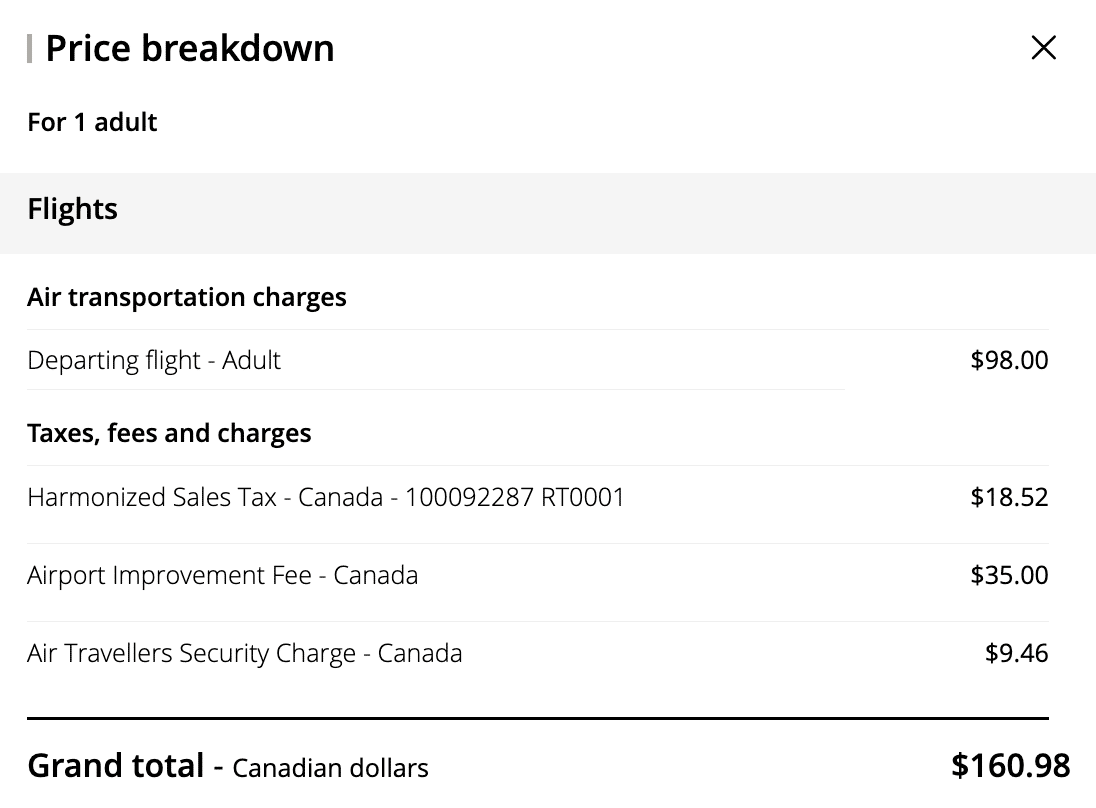It’s no secret that Canadians pay more for many common expenses than our neighbours to the south, as well as more compared to many countries across the world, for that matter.
The cost of flying in Canada is, was, and likely will continue to be no different, given our relatively small population spread out across a large area, our seasonal flying patterns, and the high government-imposed taxes and fees, amongst other reasons.
With Lynx Air recently folding and Sunwing being integrated into WestJet’s mainline operations, and as airlines continue to increase and add various fees, there’s currently no sign that flying in Canada is going to get any cheaper.
With this in mind, let’s take stock of the current state of affairs, as well as why Miles & Points is more relevant now than ever before.
In This Post
- Breaking Down Fares in Canada
- The Rise of Ancillary Revenue
- Miles, Points, and Credit Cards for the Win
- Conclusion
Breaking Down Fares in Canada
Flying within Canada is expensive compared to other countries, and it’s due to a host of factors beyond the scope of a single article.
Perhaps it’s no surprise that ultra-low-cost carrier Lynx Air wasn’t able to survive more than two years in Canada, as it had to contend with offering low base fares amidst the high government- and airport-imposed taxes and fees, a relatively small population spread out over a large area, seasonal flying patterns, the high cost of fuel, and more.
It’s worth noting that all airlines face these same issues, too; however, it’s much more challenging for an ultra-low-cost carrier to generate revenue through low base fares than it is for mainline carriers who offer higher base fares with more bells and whistles.
To illustrate this, consider that Air Canada, WestJet, Porter Airlines, and Flair Airlines all offer flights on the busy Toronto–Vancouver route.
Included in the total fares displayed above are the following amounts of taxes and fees:
- Canadian Air Travellers Security Charge: $9.45 (all figures in CAD)
- Airport Improvement Fee for Toronto Pearson: $35
- HST (which applies to the base fare), Airport Improvement Fee, Air Traveller Security Charge, and NAV Canada fees: all variable, depending on the base fare
Looking at the $87 fare charged by low-cost carrier Flair Airlines for a one-way flight from Toronto to Vancouver (in the above image), only $32.21 of this total goes to the airline. The remaining $54.43 is taxes and fees that go to external parties, which are 100% unavoidable.
In other words, only 37% of the total cost of this fare goes to the airline, and the remaining 63% goes towards taxes and fees.
(Flair includes the taxes charged for the airport improvement fee and ATSC in the cost on each line, whereas other airlines don’t).
The $32.21 that Flair receives from this fare goes to cover the cost of fuel, staffing, maintenance, APPR claims, operating costs, and all of the other expenses that come with running an airline. That doesn’t leave a lot of wiggle room, and Flair must look to other sources to generate revenue such as their fees for seat selection, baggage, meals, and more.
Comparatively, mainline carriers such as Air Canada, Porter Airlines, and WestJet all offer flights for $161 on the same day, and these correspond to a base fare and carrier-imposed surcharges of around $98 each.
Earning $98 leaves a bit more breathing room in an airline’s bottom line compared to Flair’s $32.21 for the same route.
The breathing room only expands if you also tack on the earnings from fees charged for baggage, seat selection, and more.
It’s worth noting that the fares listed above are each airlines’ lowest fare. Air Canada and Porter’s lowest fares include one free carry-on bag, while WestJet’s UltraBasic and Flair’s Basic fare don’t (they only include a personal item).
With all the different fare types to choose from across the different airlines, it’s no surprise that travellers find making the right choice a bit confusing – especially when they also have to consider the additional fees added to fares for carry-on bags, checked bags, seat selection, meals, and more.

Given all the cost variables, it can also be difficult to assess whether in fact airfare prices have gone up or not.
Unfortunately for Canadian travellers, according to data from Cirium, an aviation analytics company, the average economy base fare does appear to be on the rise compared to 2023.
According to Cirium’s data, Flair and Sunwing tend to offer to lowest base fares on average for domestic flights, followed by Air Transat, Porter Airlines, WestJet, and Air Canada. Additionally, a recent report by Flight Centre Travel Group suggests that fares for travel in July through September have risen 14% compared to the last 12 months.
To further chip away at our travel budgets, not only is the cost of base fares on the rise, but the taxes and fees imposed by airports and governments are as well.
Earlier this year, many Canadian airports raised the airport improvement fees charged to passengers, and the Air Travellers Security Charge rose by around 33% on May 1, 2024.
Therefore, even if airlines themselves aren’t increasing fares, the overall costs are rising due to factors outside of their control.
The Rise of Ancillary Revenue
The unbundling of fares and the rise of ancillary fees has been a hot topic among Canadian travellers for awhile now.
As you may have heard, both WestJet and Air Canada recently increased the cost of checked baggage fees by around $5 per passenger. This drew the ire of many passengers, who might remark that flying is expensive enough to begin with, and these added fees aren’t helping matters.
WestJet made an interesting move shortly after raising checked baggage fees by introducing a new product called Extended Comfort, which offers passengers a seat at the front of the economy cabin, an alcoholic beverage, and importantly, priority boarding (which provides early access to overhead bin space).
Many passengers might be tempted to skirt checked baggage fees by travelling with carry-on luggage only (especially with the recently increased costs associated with checked baggage), and it appears that WestJet is playing to this desire.
With the new Extended Comfort product, WestJet is offering travellers peace of mind that they won’t be left in the awkward situation of scrambling for overhead bin space; however, it now comes with an added cost (assuming you don’t have status).
Additionally, WestJet recently rolled out a bare-bones UltraBasic economy fare that limits passengers to only a small personal item (no carry-on bag included), and therefore no access to the overhead bins. With this fare, you’ll also be the last to board the plane, and you’ll probably find yourself assigned to a middle seat at the rear of the aircraft.
Furthermore, if you’d like to make your WestJet booking over the phone, you’ll now have to pay a $25–42 fee for the service (depending on your fare). This fee is aligned with or slightly more than what ultra-low-cost carrier Flair Airlines charges for phone bookings.
While WestJet’s recent changes to its fares and fees appear to be in line with low- or ultra-low-cost carriers, Air Canada recently added complimentary beer, wine, and snacks for all economy passengers on domestic and transborder flights, aligning it with exactly what Porter Airlines has offered for years.
Whether ancillary fees and this style of fare structure is a good or bad thing can be a matter of personal preference.
On the one hand, some passengers dislike these unbundled fares, which draw you in with low prices but wind up costing significantly more as you add extras like baggage, meals, or seat selection fees. What was initially an $87 flight can easily rise to double or triple the cost once you’ve added your extras.
On the other hand, some passengers like the flexibility of booking the lowest fare and travelling in an assigned seat with a small backpack and a snack, so as to not incur more charges.
This latter scenario is not an option for many travellers, however, so when you’re shopping for fares, be sure to look at what’s included with the higher fares, as it may wind up being cheaper than the lowest fare with added extras.
The unbundling of fares is a trend that’s likely to continue, and it’ll be interesting to see the next steps that airlines take.
Miles, Points, and Credit Cards for the Win
No matter how you like to fly, be it with mainline carriers or ultra-low-cost carriers, one surefire way to keep costs down is to have and leverage the right credit card.
If you balk at the high cost of domestic airfare, but want to fly from Vancouver to Halifax to visit relatives this summer, earning points on your day-to-spending can be an excellent way to offset the cost of getting there, regardless of carrier.

When it comes to flying with mainline carriers like Air Canada and WestJet, you can easily skirt the increasing costs of checked baggage fees by holding the right co-branded credit card.
Consider, for example, that if a checked bag costs around $35 per person at minimum, a single round-trip booking for two would incur $140 in checked baggage fees alone (assuming they’re not included in the fare or otherwise).
That’s equal to or greater than the cost of an annual fee for many co-branded credit cards, with which you can get a free checked bag per person on associated flights, regardless of which fare you book.
If you travel more than once a year, your credit card can effectively pay for itself over and over again, and that’s not considering any other perks that come with it.
Credit Card
Best Offer
Value
Up to 40,000 Aeroplan points†
$683
Apply Now
40,000 Aeroplan points
$573
Apply Now
70,000 WestJet points†
$556
Apply Now
Up to 45,000 Aeroplan points†
$525
Apply Now
It’s also worth noting that fixed-value points currencies can play a great role in reducing the cost of travel, even with ultra-low-cost carriers.
If you prefer to travel as cheaply as possible, you may want to consider collecting Scene+, CIBC Aventura Points, BMO Rewards, or TD Rewards Points, amongst other fixed-value currencies. This is because you can redeem the points you earn on your credit cards against travel purchases at a rate of 0.67–1.25 cents per point, depending on the program.
Plus, many mid-tier cards come with a strong travel insurance coverage, which means you’ll be covered if your flight is cancelled or delayed and you’re left stranded at the airport (assuming you follow the terms and conditions of the card).
While we can’t do anything to change the rising cost of travel, we can leverage what’s possible through Miles & Points by pairing the right credit card with our travel goals.
Conclusion
Flying in Canada isn’t cheap, and there are no signs that it’s going to become more affordable anytime soon.
As some airlines exit Canadian airspace and others increase ancillary fees, and while governments and airports increase their fees, the best approach to saving money on travel is to pair your travel goals with the right credit card.
By earning points on your daily spending and carefully considering the benefits available on credit cards, you can fuel your travels without draining your bank account.
























tl;dr – yes
Lynx folded cause they blatantly had bad customer service and hidden costs. Remember when Westjet launched, they emphasized their customer experience and we’re able to lock in many repeat customers.